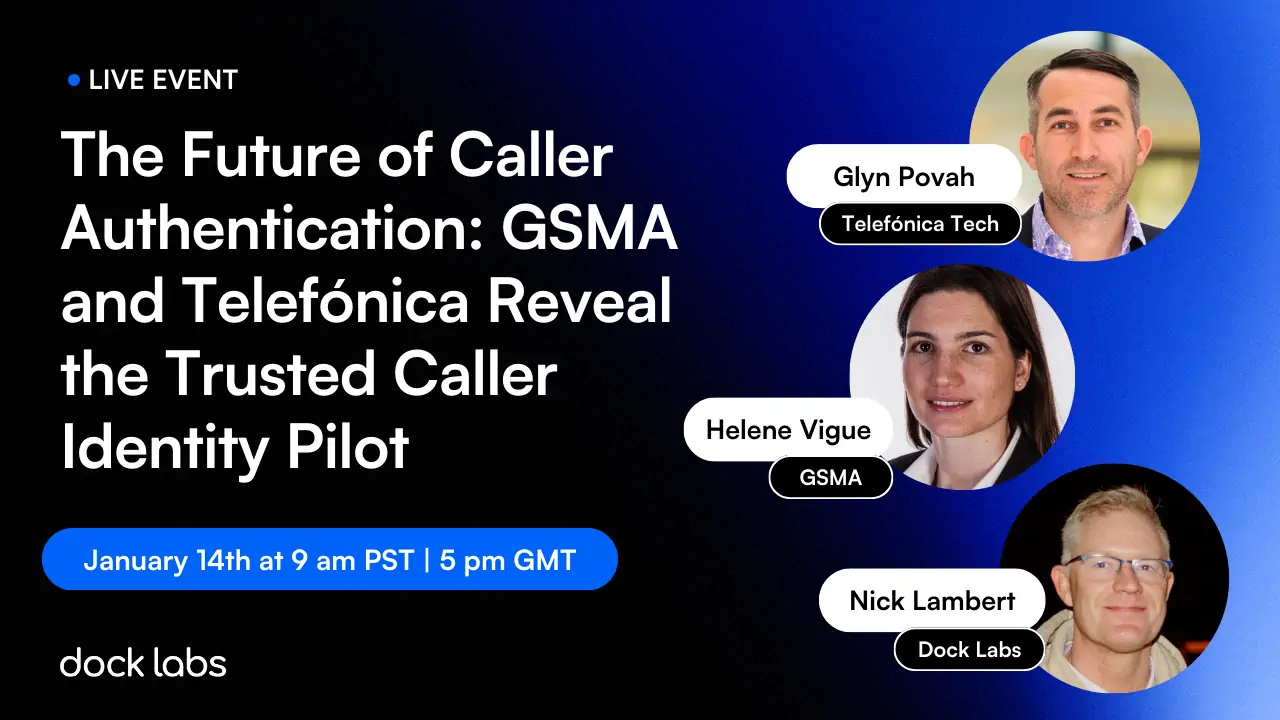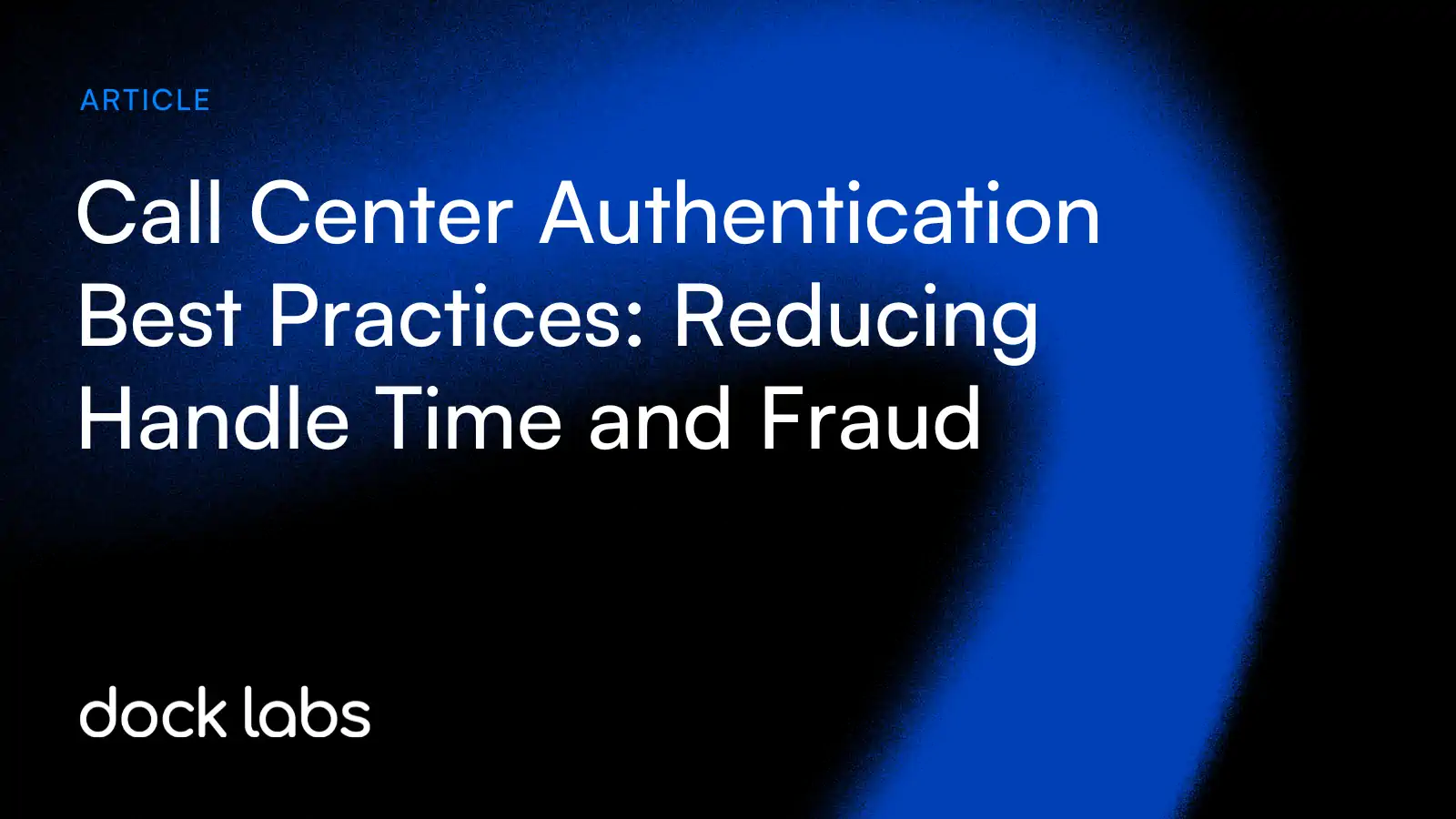Every extra second your agents spend verifying a caller’s identity is time and money lost. Across thousands of calls, slow authentication adds up to hours of wasted handle time, frustrated customers, and unnecessary operational costs.
At the same time, outdated methods like security questions and one time passcodes leave call centers exposed to phishing, SIM swap attacks, and Caller Line Identification (CLI) spoofing.
To solve both problems, leading organizations are rethinking how they authenticate callers. In this post, we’ll break down the most effective call center authentication best practices that help reduce handle time, strengthen fraud prevention, and protect customer privacy.


Common Weak Points in Today’s Authentication Workflows
Most call centers still rely on authentication processes designed decades ago. While they technically “work,” they’re slow, inconvenient, and vulnerable to modern threats. Here are some of the biggest weaknesses that hold authentication back today.
Overreliance on Knowledge-Based Questions
Callers are still asked to confirm details like their address, date of birth, or recent transactions. These answers are easy to find or guess, especially with so many data breaches exposing personal information online. Every extra question also adds friction and handle time.
Use of OTPs Over Insecure Channels
Sending one-time passwords (OTPs) by SMS or email may seem convenient, but it’s a growing security risk. OTPs can be intercepted through SIM swap attacks, phishing, or Caller Line Identification (CLI) spoofing, allowing fraudsters to bypass authentication completely.
Agents Handling Sensitive Data
When customers verbally share personal information for authentication, agents are exposed to sensitive data that can be overheard, recorded, or mishandled. This not only raises privacy and compliance risks but also slows down calls as agents must manually capture and confirm the data.
Re-Authentication During Transfers
Even when a customer is verified once, many call centers force them to re-authenticate after being transferred to another department. This redundancy increases handle time, frustrates callers, and signals a lack of integration between systems.
These inefficiencies increase handle time and create vulnerabilities that modern call center authentication methods are designed to solve.
Best Practices for Faster, Safer Call Center Authentication
Improving caller authentication doesn’t require a complete overhaul, just smarter design and better use of technology. The most efficient contact centers follow these proven best practices to verify customers faster, prevent call center fraud, and protect privacy.
Pre-Authenticate Callers Through the Mobile App or IVR
Start verifying identity before the caller reaches an agent. If a customer uses your mobile app (e.g bank or telecom), you can authenticate them automatically through device-based or biometric verification, confirming their identity.
In the pilot we did with one of the world’s largest telecom providers, this technology was successfully used to authenticate callers directly through the company’s existing mobile app, enabling instant, biometric confirmation without OTPs or security questions.
The same system could also be extended to IVR-based pre-verification. When a customer calls, the IVR could trigger a push notification to their app asking them to confirm the call. The customer unlocks the app with biometrics and approves the request, allowing the agent to see a Verified status as soon as the call begins.
This pre-verification flow can save 30–90 seconds per call while reducing fraud risk and improving the customer experience.
Combine Multiple Authentication Signals
Layering biometrics, device recognition, and verifiable credentials offers stronger assurance than relying on one method alone. Even if one signal fails, others validate the caller’s identity, making social engineering and account takeover fraud far less likely.
Streamline the Agent Workflow
Integrate authentication directly into the agent’s interface so verification happens with one click, not multiple systems. Agents should see a simple “Verified” or “Not Verified” status instead of manually cross-checking data. This reduces handle time and cognitive load.
Maintain Authentication Across Transfers
Once a caller is verified, that authentication status should persist across departments and agents. Repeating security questions at every handoff frustrates customers and signals weak process design. Shared verification states or session tokens solve this.
Keep Personal Data Off the Call
Avoid having callers share personal details like birth dates or addresses. Instead, use digital confirmation. For example, the customer approves the verification request in their mobile app. This approach enhances fraud prevention and eliminates compliance risk.
Measure and Optimize Regularly
Track how long authentication takes and its impact on Average Handle Time (AHT), fraud rates, and false rejections. Even small efficiency gains translate into major cost savings at scale. Continuous measurement ensures improvements are both sustainable and visible.
Call Center Authentication Best Practices Real-World Example
To demonstrate how biometric and credential-based verification can improve call center authentication, GSMA, Telefónica Tech, and TMT ID partnered with Dock Labs to test a new privacy-preserving model of caller authentication.
The pilot explored how verifiable credentials and biometric verification could replace traditional security questions and OTPs, allowing agents to confirm a caller’s identity instantly, without exposing personal data.
Using a test mobile app, customers received a push notification to confirm they were the ones calling. After unlocking the app with biometrics and tapping “Yes,” the agent instantly saw a verified status on screen. The result was a faster, more secure authentication experience that reduced the opportunity for phishing, SIM swap, and Caller Line Identification (CLI) spoofing attacks.
Even though a test mobile app was used, the plan is to integrate this ID verification capability into a company’s existing app (e.g. bank or telecom). This would allow a contact center to verify the caller’s identity without needing them to download an extra app.
The pilot proved that digital credentials and biometric verification can bring significant gains in both speed and security, setting a strong foundation for how large organizations can modernize authentication across contact centers.
Implementing These Call Center Authentication Best Practices with Verifiable Credentials
The easiest way to put these best practices into action is by using verifiable credentials and biometric verification within your company’s existing mobile app.
Instead of relying on security questions or OTPs, customers can confirm who they are with a single tap on their phones.
When a caller contacts the center, the agent simply clicks “Authenticate Caller.” on their portal.
The customer receives a push notification in the organization’s mobile app, unlocks it with a biometric, and confirms they are the ones contacting support. The agent sees a Verified status within seconds.
No personal data is shared, no answers are spoken aloud, and the entire exchange happens through a fully dedicated encrypted channel.
Because the digital ID wallet is embedded directly inside the organization’s app, customers don’t need to download anything new, and integration for the contact center team is straightforward through a lightweight REST API.
This approach combines all the best practices covered in this post (speed, layered security, privacy, and simple user experience) into one modern framework for call center authentication.
Key Takeaways
- Traditional authentication methods like security questions and OTPs are slow, insecure, and expose customers to fraud risks such as phishing, SIM swap attacks, and CLI spoofing.
- Implementing the right call center authentication best practices can significantly reduce handle time, improve customer satisfaction, and strengthen security.
- Layering biometrics, device signals, and verifiable credentials creates a faster and more reliable way to verify identity while keeping personal data private.
- The GSMA and Telefónica pilot demonstrated how this model can replace outdated authentication steps with instant, privacy-preserving verification through an organization’s existing app.
- With solutions like Truvera’s Call Center Authentication, contact centers can authenticate callers in seconds: lowering costs, preventing fraud, and protecting privacy.
FAQ: Call Center Authentication Best Practices
1. What are call center authentication best practices?
They’re proven methods to verify a caller’s identity quickly and securely while maintaining a smooth experience. Best practices include pre-authenticating callers through mobile apps or IVR, combining multiple verification signals (biometrics, device, credentials), and keeping personal data off the call.
2. How can call centers reduce handle time during authentication?
By moving away from manual checks like security questions and using faster, automated flows. For example, when callers confirm their identity through a push notification and biometric in the company’s mobile app, agents can skip lengthy questions and immediately begin resolving the issue.
3. How do verifiable credentials improve authentication?
Verifiable credentials allow a call center to authenticate a customer, without exposing any personal data. Combined with biometric verification, they enable instant, privacy-preserving trust between the caller and the agent.
4. What did the GSMA and Telefónica pilot demonstrate?
The pilot showed that call centers can replace slow, question-based authentication with digital credentials and biometric verification inside the organization’s existing app. This model reduced verification time and helped prevent fraud attempts linked to phishing and SIM swap attacks. The pilot used Dock Labs’ technology.
5. How can I implement these best practices in my organization?
Modern call center authentication solutions like Truvera’s Call Center Authentication make it simple. They integrate into your agent portal via a REST API and embed a secure digital ID wallet inside your existing app, allowing you to authenticate callers in seconds, without passwords, OTPs, or compliance risks.






